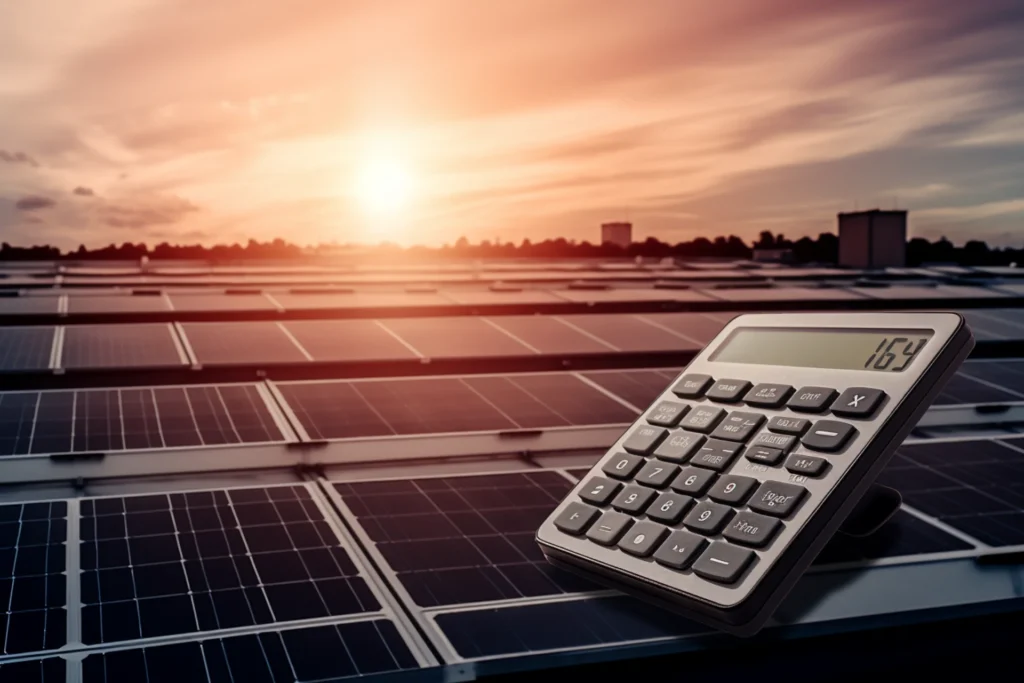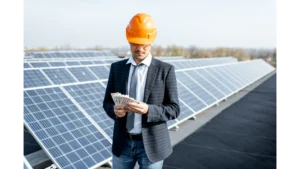
Investing in a solar panel system for your home should not be taken lightly. While the benefits of generating renewable energy are numerous, it’s important to understand the initial costs and how long it will take for your investment to pay off. This article will explore the factors that affect the timeline for recouping your investment, including the size of the system, cost of electricity in your area, amount of energy your household consumes, potential savings from solar energy, rebates and incentives, financing options, maintenance, and longevity.
Solar panels have become increasingly popular among homeowners as a way to reduce their dependence on traditional power sources and potentially save money on their energy bills. However, before making this investment decision, it’s crucial to clearly understand what you’re getting into financially. By taking into account all the relevant factors and doing some careful calculations, you can determine how long it will take for your solar panel system to pay for itself and whether this option is right for you.
The initial investment required for a solar panel system can vary greatly depending on various factors, such as the size of the system, location, and installation costs. Understanding the ROI is crucial in determining how long it will take for the system to pay for itself. The ROI, or return on investment, is a financial metric used to evaluate the profitability of an investment. It measures how much profit or savings an investment generates compared to its cost.
Compared with other investments, a solar panel system is considered a long-term investment that may take several years to pay for itself. However, once it does, it has the potential to provide significant savings and financial benefits over its lifespan. On average, most residential solar panel systems have an ROI of five to eight years. This means that you can expect your energy bills to be significantly lower or even eliminated entirely after this period.
It’s worth noting that larger systems usually have higher upfront costs but offer greater long-term savings than smaller ones. Additionally, location plays a significant role in determining the ROI of your solar panel system due to differences in electricity rates and weather conditions across different regions. To maximize your savings potential and ensure your system’s optimal performance, you should work with experienced solar installers who understand these nuances.
In summary, understanding the initial investment required for a solar panel system is essential in determining its ROI and how long it will take to pay off. While it may take several years to see any returns on your investment, investing in a solar panel system offers significant benefits, such as reduced energy bills and increased property value. Comparing with other investments available and considering location-specific factors such as electricity rates and weather conditions when choosing the right-sized system from reliable professionals will help you achieve maximum financial benefit from your decision.
Determining the size of a solar panel system is crucial in achieving energy efficiency and cost-effectiveness. The size of the solar panel system directly impacts its payback period, as larger systems require higher initial investments but generate more electricity and savings in the long run. Along with other factors such as location, household energy consumption, and shading, calculating the appropriate size of a solar panel system is essential for making informed decisions regarding renewable energy adoption.
Calculating the appropriate size of a solar panel setup is an essential step toward determining the economic feasibility of utilizing solar energy. Maximizing efficiency and choosing the right location are crucial factors that should be considered in determining the size of a solar panel system. In maximizing efficiency, it is important to consider using high-efficiency panels with higher power capacity per unit area. This means less space will be required for installation, reducing overall costs. Additionally, installing efficient inverters can increase the amount of power each panel produces.
Choosing the right location also plays a significant role in determining the appropriate size of a solar panel system. Areas with high levels of sunlight exposure are ideal for generating more electricity from each panel. It is important to consider any obstructions, such as trees or buildings, that may cast shadows on panels during peak sun hours. The orientation and tilt angle of panels should also be considered to maximize their exposure to sunlight throughout the day. Considering these factors, one can determine an optimal size for their solar panel system that maximizes energy production while minimizing costs over time.
• Use high-efficiency panels
• Install efficient inverters
• Choose areas with high levels of sunlight exposure
Evaluating the impact of varying system sizes on the payback period is crucial in determining the economic viability of utilizing solar energy. The size of the solar panel system directly affects how much energy it can produce, which in turn impacts its efficiency and, ultimately, its payback period. It is important to note that while larger systems may generate more electricity, they also require a higher upfront investment.
System efficiency is another key factor in the payback period for solar panel systems. High-efficiency panels can produce more power per square foot than their less efficient counterparts, meaning smaller systems can produce similar amounts of energy as larger ones. Additionally, geographical location plays a significant role in determining system efficiency and payback periods. Areas with high levels of sunlight will generally see shorter payback periods than regions with lower levels of sunlight. Therefore, when considering different system sizes for potential installation locations, it’s essential to account for all these variables before making a final decision.
System Size | Annual Energy Production (kWh) | Payback Period (years) |
2 kW | 2,800 kWh | 10-14 |
4 kW | 5,600 kWh | 8-12 |
6 kW | 8,400 kWh | 7-10 |
8 kW | 11,200 kWh | 6-9 |
The table above illustrates how varying system sizes impact both annual energy production and estimated payback periods. As shown in the table above, larger systems tend to have shorter payback periods due to economies of scale; however, smaller systems may still be feasible depending on factors such as geographic location and available space for installation. Ultimately though, when deciding on an appropriate size for your home or business needs – considerations like budget constraints should also be taken into account alongside these factors.
To determine the payback period of your solar panel system, it is crucial to understand the cost of electricity in your area. Understanding electricity rates can help you make informed decisions about the size and type of solar panel system you need for your home or business. The impact of electricity rates on the payback period of a solar panel system cannot be overstated, as it directly affects the financial viability of investing in renewable energy.
The section on Understanding Electricity Rates provides valuable insight into the financial return of a solar panel investment. One important factor to consider is the electricity rate comparison in your area. This involves researching and comparing the cost of electricity from your local utility company with the cost of generating your electricity through solar panels. In some areas, the cost of producing energy through solar panels may be lower than purchasing energy from a utility company, resulting in significant savings on monthly bills.
Another factor to consider is the renewable energy subsidies available in your area. These incentives can include tax credits, rebates, or other financial benefits that make it more financially viable to invest in solar panels. By taking advantage of these subsidies, you can offset some of the initial costs associated with installing a solar panel system and increase the overall financial return on your investment over time. It’s important to research and understand all aspects related to electricity rates and renewable energy subsidies before deciding to invest in solar panels for your home or business.
Analyzing the correlation between electricity rates and the payback period for solar panel investments can provide insight into the financial viability of such investments. Electricity cost analysis is crucial in determining how much money a homeowner can save using solar panels. The payback period for a solar panel investment depends on several factors, including the cost of electricity in the area, the amount of energy consumed by the household, and the initial investment.
To accurately determine if investing in solar panels is financially viable, comparing energy consumption before and after installation is important. This comparison can be used to calculate potential savings over time. Additionally, comparing electricity rates in different areas is essential to understand how they impact payback periods. An area with higher electricity rates may have a shorter payback period than an area with lower rates due to greater potential for savings. Understanding these factors is key to making informed decisions about investing in solar panel systems.
• Conducting an electricity cost analysis is necessary when investing in solar panels.
• Comparing energy consumption pre-and post-installation provides useful information for calculating potential savings.
• Electricity rates play a significant role in determining how much money homeowners save through their investments.
• Higher electricity rates do not necessarily translate into longer payback periods; instead, other factors, such as energy consumption, should also be considered.
Calculating your household’s energy usage is an essential step in determining the potential payback period of a solar panel system. By analyzing energy consumption patterns, you can identify areas where energy efficiency improvements can be made to reduce overall electricity usage. These improvements can significantly impact a solar panel system’s payback period and return on investment.
By evaluating your energy consumption, you can determine the amount of electricity generated by a solar panel system needed to offset your energy usage and achieve cost savings. To begin calculating your energy usage, start by understanding the factors that contribute to it. The number of people in your household, the size of your home, and the types of appliances you use all play a role in determining how much electricity you consume.
Once you understand these factors, you can analyze your energy consumption more closely. Look at your utility bills over the past year to know how much electricity you typically use monthly. You can also use online tools or apps to estimate how much energy-specific appliances use and identify areas where you may be able to reduce usage. By taking these steps, you’ll better understand how much electricity a solar panel system will need to generate for you to achieve cost savings over time.
Understanding the impact of energy consumption on the payback period of a solar panel investment is crucial in determining the feasibility and financial benefits of transitioning towards renewable energy sources. To calculate your solar panel system’s payback period, you must analyze your electricity usage and determine how much energy you consume daily. The amount of electricity used directly affects how quickly you can recoup your initial investment.
Renewable energy alternatives like solar panels can reduce or eliminate your monthly electricity bill. However, it is important to note that if you still consume a significant amount of electricity from the grid after installing a solar panel system, it will take longer for the system to pay for itself. Thus, reducing your overall energy consumption through lifestyle changes or implementing additional energy-efficient measures in combination with installing a solar panel system can significantly decrease its payback period.
The potential for significant cost savings through solar energy is evident, as it can significantly reduce reliance on traditional power sources and lower monthly electricity bills. Calculating ROI is important in determining the financial benefits of installing a solar panel system. Depending on factors such as location, available sunlight, and government incentives, the payback period for a residential solar panel system can range from 5 to 15 years.
Aside from financial savings, environmental benefits should be considered when switching to solar energy. Solar panels generate clean and renewable energy that does not produce harmful greenhouse gas emissions like traditional power plants. By reducing one’s carbon footprint through solar energy, individuals can contribute towards a healthier planet.
In addition to personal cost savings and environmental benefits, installing a solar panel system may also increase property value. According to studies conducted by the National Renewable Energy Laboratory (NREL), homes with solar panels installed have increased resale values compared to similar homes without them. This means that if homeowners decide to sell their property in the future, they could potentially recoup some or all of their initial investment in their solar panel system.
Overall, the potential savings from using solar energy are vast and varied. From reducing monthly electricity bills to contributing towards a healthier planet and increasing property value, investing in a residential solar panel system offers numerous long-term benefits beyond just financial ones.
This section explores the various rebates, incentives, and tax credits available for those investing in solar energy. Renewable energy sources have become increasingly popular as people look for ways to reduce their carbon footprint and save money on energy bills. The government has recognized this trend and has implemented several initiatives to encourage the adoption of renewable energy sources such as solar power.
One of the government’s most significant incentives is the federal investment tax credit (ITC). This credit allows homeowners who install a solar panel system to deduct 26% of the total cost from their federal taxes. This incentive alone can significantly reduce the payback period for a solar panel system. Additionally, many states offer their tax credits or rebates that can further reduce costs.
Another initiative aimed at promoting renewable energy sources is net metering. Net metering allows homeowners with solar panels to sell excess electricity back to the grid, effectively reducing their electricity bill. Some states even require utilities to offer net metering programs, making it easier for homeowners to take advantage of this benefit.
Finally, some utility companies offer performance-based incentives (PBIs) or feed-in tariffs (FITs) that pay homeowners for every kilowatt-hour of electricity their solar panel system generates. These programs incentivize homeowners to generate as much electricity as possible and can help offset installation costs over time.
In conclusion, several rebates, incentives, and tax credits are available for those interested in investing in solar energy. These initiatives aim to promote renewable energy sources while making them more accessible and affordable for homeowners. By taking advantage of these programs, homeowners can significantly reduce the payback period for a solar panel system while contributing to a cleaner environment.
This section discusses financing options for solar panel systems, which is an important consideration for those interested in installing such systems. Various financial instruments and models exist to help potential buyers afford the upfront cost of purchasing and installing a solar panel system. The type of financing chosen can significantly affect the payback period and total amount paid over time, so it is worth exploring different options carefully before deciding.
Financing options for solar panel installation are important in determining the feasibility of implementing a solar energy system. One financing option is a solar panel lease, which allows homeowners to rent the panels from a third-party provider. This option typically requires little to no upfront cost and provides immediate savings on electricity bills. However, the homeowner does not own the panels and may be locked into a long-term contract with limited flexibility.
Another financing option is a solar panel loan, which allows homeowners to purchase the panels outright or through financing with low-interest rates. This option provides ownership of the panels and may result in greater long-term savings than leasing. However, there may be higher upfront costs associated with this option, and homeowners must consider if they have the financial resources to make these payments. Understanding these different financing options can help homeowners determine which method best suits their financial situation and goals for implementing solar energy systems.
The payback period of a solar energy system can be greatly influenced by the chosen financing option, highlighting the importance of carefully considering the pros and cons of each before making a decision. Several loan types are available to finance a solar panel installation, including secured loans, unsecured loans, home equity loans, and personal loans. Secured loans generally have lower interest rates since they require collateral such as your home or car to secure the loan. Unsecured loans do not require collateral but may come with higher interest rates.
Interest rates also play a significant role in determining the payback period of a solar panel system. When taking out a loan for solar panels, it is important to shop around for competitive interest rates that match your financial situation. A lower interest rate means less money paid over time and a shorter payback period. In contrast, high-interest rates can significantly prolong the payback period, resulting in higher costs over time. Therefore, carefully weighing different loan options and their corresponding interest rates can ultimately lead to substantial savings in both energy bills and overall financing costs.
The maintenance cost of solar panels is important for those looking to install a solar panel system. A properly maintained solar panel system can last up to 25 years, but the longevity of the panels and other components can have a significant impact on the payback period. Understanding the costs associated with maintaining a solar panel system and how it affects its lifespan is crucial for making informed decisions about solar energy investments.
Regular maintenance of a solar panel installation is necessary to ensure its optimal functioning and longevity, which can add to the overall costs of owning such a system. The frequency of maintenance required for solar panels depends on several factors, including the location, weather conditions, and type of equipment used. Generally, it is recommended to have an annual inspection by a professional installer or technician to check for any issues with wiring, connections, or other components that may need repair or replacement.
The cost of repairs for solar panels can vary depending on the extent of the damage and the type of equipment needed for replacement. Sometimes, minor repairs such as cleaning or replacing damaged wires may only cost a few hundred dollars. However, more extensive repairs, such as replacing damaged panels or inverters, can cost thousands of dollars. It is important for homeowners considering solar panel systems to factor in these maintenance costs when calculating the overall financial benefits and payback period for their investment in renewable energy.
The duration of a solar panel system’s lifespan is a crucial factor influencing the financial benefits and return on investment, as it directly impacts the energy generated and maintenance costs incurred over time. The longer a solar panel system lasts, the more energy it generates and the less frequently it requires maintenance or upgrades. This means that the payback period for a solar panel system will be shorter if its lifespan is extended.
Maintenance costs are one of the key factors impacted by longevity in solar panels. As systems age, they require more frequent repairs and replacements of parts such as inverters or batteries. These can add up over time and reduce the overall financial benefit of installing solar panels in the first place. On the other hand, if a solar panel system has a long lifespan, these costs can be significantly reduced, making them more financially viable in the long run. Similarly, upgrading systems to keep up with new technology can become costly over time, but extending their lifespans means fewer upgrades are needed to sustain their efficiency levels.
Based on the financial analysis, it is evident that investing in a solar panel system can prove to be a wise decision with significant long-term benefits. The payback period for a solar panel system depends on various factors, such as the installation cost, local utility rates, and available incentives. However, once installed, solar panels generate electricity without any recurring costs and have an expected lifespan of 25-30 years.
Analyzing ROI is crucial to determine the payback period for a solar panel system. Although initial investment costs may seem high, future benefits such as energy savings and lower utility bills make up for it in the long run. Moreover, homeowners who generate surplus electricity from their solar panels can sell it back to the grid through net metering programs offered by utilities.
It is important to note that while some incentives may expire after a certain period or change according to state policies, other options like tax credits and rebates could help offset installation costs. Additionally, technological advancements continue to improve efficiency and reduce solar panel costs, making them even more viable for households.
In conclusion, investing in a solar panel system has numerous long-term benefits, from reducing carbon footprint to saving money on energy bills. With careful consideration of ROI analysis and available incentives in your area, investing in renewable energy has become increasingly attractive for both environmental and financial reasons. Therefore, if you have an underlying desire for freedom by being less dependent on traditional utilities, installing a solar panel system could be an excellent solution.
In conclusion, determining the payback period of a solar panel system requires considering multiple factors. The initial investment is significant and depends on the size of the system, installation costs, and equipment quality. Understanding the cost of electricity in your area and the amount of energy your household consumes is essential for estimating potential savings from solar energy.
Rebates, incentives, and tax credits can significantly reduce upfront costs and shorten the payback period. Financing options such as loans or leases are also available to make solar energy more accessible to homeowners with limited funds. Proper maintenance and longevity of solar panels are crucial for ensuring maximum efficiency over time.
Investing in solar panels can be a smart long-term financial decision for homeowners looking to save money on their electricity bills while reducing their carbon footprint. However, careful consideration of various factors is necessary before deciding to purchase a solar panel system.
When considering installing a solar panel system, it is important to consider any additional costs associated with the process. One such cost includes permit fees which local governments require for approval to install solar panels on residential or commercial buildings. Additionally, installation fees may be incurred due to hiring professionals to complete the installation process. However, financing options such as loans and leases may be available to help cover these costs. Tax incentives can also be applied towards the system’s total cost, helping offset any upfront expenses. It is important to consider all of these factors when calculating the payback period for a solar panel system and determining its overall financial viability.
The weather in a specific geographic location can greatly affect the performance of a solar panel system. Seasonal variations such as temperature and sunlight hours can impact the panels’ efficiency, resulting in lower energy production during certain times of the year. Panel orientation is also important to consider as it determines how much direct sunlight the panels receive throughout the day. Shading caused by surrounding buildings, trees, or other obstructions can further decrease panel output. To optimize energy generation, it is crucial to ensure that panels are installed at an appropriate angle and direction with minimal shading. Understanding and accounting for these weather-related variables is imperative for maximizing solar panel efficiency and generating sufficient energy for household needs.
When a solar panel system produces more energy than a household consumes, the excess energy is sent back to the grid. Net metering benefits allow homeowners to receive credits on their utility bills for the excess energy produced and sent back to the grid. This means that when a household’s solar panels are not producing enough energy, they can use these credits to offset the cost of drawing electricity from the grid. Energy storage options, such as batteries, provide an alternative solution for homeowners who want to store excess solar energy for later use instead of returning it to the grid. These options give homeowners greater control over their energy usage, allowing them to maximize their investment in renewable energy technology while reducing their reliance on traditional power sources.
Assessing the suitability of a home for solar panel installation requires evaluating several structural requirements:
These factors can help determine if a home is suitable for solar panel installation while maximizing energy production efficiency and reducing dependence on traditional power sources.
Selling excess energy back to the grid is a common way for solar panel system owners to generate income. This process, known as net metering, enables homeowners to receive credits on their electric bills for any excess energy they produce and feed back into the grid. Net metering policies may vary by state and utility company, so potential solar panel system owners need to research the specific regulations in their area before investing in a system. By taking advantage of net metering opportunities and selling excess energy back to the grid, solar panel system owners can offset their own electricity costs and potentially earn income from their investments.

Can I Lease Solar Panels Instead Of Purchasing Them? As the world becomes increasingly environmentally conscious, more individuals and businesses are turning to renewable energy

How Does The Installation Of Solar Panels Affect My Property Taxes? With the increasing concern for the environment and the need to reduce carbon emissions,

What Kind Of Financing Options Are Available For Solar Panel Installation? What Financing Options Are Available For Solar Panel Solar panel installation is an increasingly

What Happens If My Solar Panels Generate Excess Solar Power? Solar Panels Generate More Electricity Than I Use As more homeowners turn to renewable energy

How Does The Installation Of Solar Panels Affect My Homeowners Insurance? How Solar Panels Affect My Homeowners Insurance The installation of solar panels has become

State Grants The Database of State Incentives for Renewables & Efficiency (DSIRE) is a comprehensive source of information on federal, state, local, and utility incentives